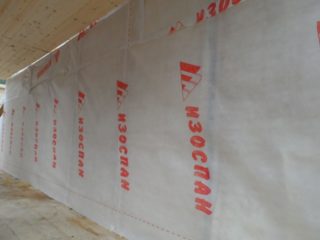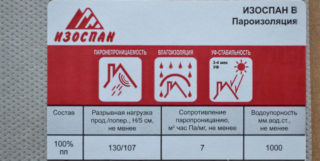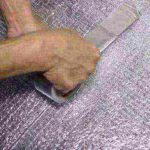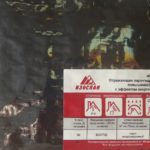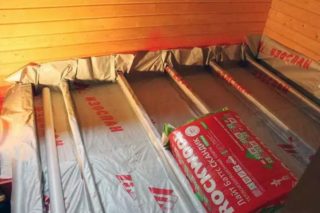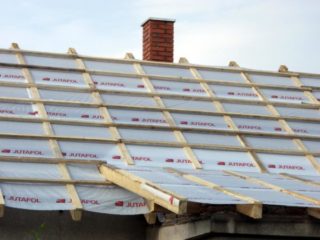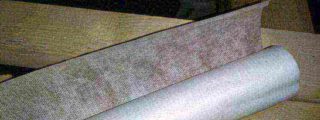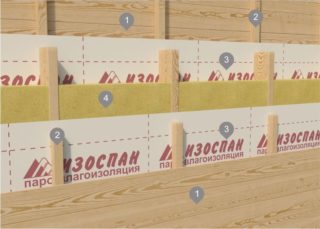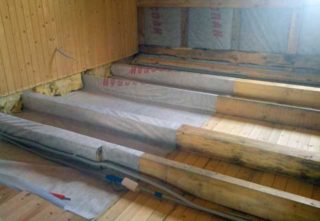Isospan is a type of vapor-permeable membrane. Passes steam only in one direction. If the material is installed correctly, it protects the insulation from moisture, if not, the heat insulator will get wet. Which side to put Isospan A to the heater depends on its structure.
Izospan A, B, C, D - general information
Izospan is a large group of non-woven material and films. Its purpose is not to let steam pass through to insulating structures, to walls or roofs, but not to prevent evaporation of moisture from the heat insulation. This is its difference from waterproofing, which does not allow moisture to pass in either direction.
There are 3 groups: windproof membranes that protect against moisture, hydro- and vapor barrier films, vapor insulators that retain heat - foil. A more conditional classification divides Izospan into groups A, B, C, D.
Isospan A protects the material from moisture and wind coming from outside, but does not interfere with the removal of moisture from the insulation layer. The outer side of the membrane is smooth, repels water, the inner is rough. In the pie, the membrane is placed in front of the heater from the side of the roof so that water and moisture from the air outside do not penetrate the heat-insulating layer.
Apply modification A:
- when insulating slopes with an inclination angle of more than 35 degrees;
- for vapor barrier frame walls;
- when cladding facades with siding or lining;
- as wind protection under a ventilated facade.
Izospan B - vapor barrier film, used only for interior use. This is a two-layer material with a smooth outer and fleecy inner surface. Unlike modification A, this option does not let in not only steam from the air, but also condensate that forms when the humidity is excessive in the attic or indoors.
Vapor barrier B use:
- when arranging floors - required when installing wooden and wood-based coatings such as battens, boards, laminate, parquet;
- at installation of cattle and flat roofs;
- to protect any floor of the house - basement, mezzanine, attic;
- for warming structures in the room.
Isospan C is a type of hydro and vapor barrier membrane. Its difference is increased density. The modification is used for vapor barrier of wooden structures - floors, walls, floors. When arranging a concrete screed, the membrane can be put instead of a waterproofing film.
Isospan D - the polypropylene base is laminated on one side. The material is very durable, has increased water resistance. The application is diverse:
- to protect wooden roofs;
- when arranging the basement floor;
- when installing a concrete screed;
- like temporary roofing or a protective wall. This design serves 4 months;
Isospan with a lamination kraft paper reflects thermal radiation. It is used for vapor barrier baths and saunas.
Brands FB, FD, FS and other models from the foil membrane group not only vaporize walls or roofs, but also retain heat.
All types of Izospan are made from polypropylene. It does not cause allergies, is safe for health and is not affected by fungi.
- For baths and saunas
- Laminated film
- Increased strength
Material Specifications
To choose the appropriate option, evaluate many parameters of the film. The stronger it is, the longer it will last, and the more difficult it will protect.The higher the vapor permeability, the faster the moisture that gets into it will be removed from the insulation.
| Material | Density, g / sq. m | Vapor permeability, g / sq. m / day | Water resistance, mm. Water. st | Temperature range, C |
| Isospan A | 70 | 22,4 | 330 | -60–+80 |
| Isospan B | 90 | 18,4 | 1000 | -60–+80 |
| Isospan C | 105 | 3,7 | 1000 | -60–+80 |
In each case, additional qualities may be required from the material. Modification A with OZD belongs to the 1st class of flammability, since it contains flame retardant additives. Option B is used only inside the building. The group C vapor barrier has the same purpose, but because of its high strength, it is used in loaded areas. Its cost is 50-60% higher.
Assortment Overview
Each group of materials includes modifications with a different structure. The mechanism of action of all membranes of the same group is the same, but the structure and properties are different.
The Isospan A line includes:
- A - its vapor permeability is maximum at a higher density - 110 g / sq. m. When it is laid, it is necessary to leave a gap for ventilation.
- AM is a three-layer membrane. It is installed without a ventilation gap: air passes between the layers of the vapor barrier and removes moisture.
- AS - has the same properties as the previous modification, but is denser - 115 g / sq. m
- AQproff is a vapor barrier with a three-layer structure and reinforced reinforcement. Designed for external use. It is also used as temporary protection of a wall or roof for a while, while there is no main finish.
- A with OZD - fire-resistant vapor barrier. A non-combustible membrane is installed when the ventilation facades are insulated. A with OZD is also used during welding to protect the insulated structures located near the work area.
Izospan B and C are varieties of vapor barrier with anti-condensation film. Their purpose is the same and they differ only in strength.
Features of the correct installation of Izospan A to the insulation
Which side to put Izospan to the insulation depends on its type. Group A materials work according to the check valve principle: they release air and steam, but do not let anything in. To protect the heat insulator, such a membrane is laid with the “front” side on the street.
Do not confuse the sides of the membrane. Facial - smooth, water-repellent, facing "outside", the rough internal is turned to the heater. Sell the material in rolls. It is cut into wide strips and laid with an overlap of 15 cm.
When laying Izospan between it and the insulation leave a gap. If they take the brand AS or AD, the gap is not done.
During installation, the film must be tensioned. Otherwise, with gusts of wind, it will hit the surface and be damaged.
Laying Isospan B
The smooth side of the film does not allow water to pass through, while the rough side absorbs condensate and evaporates it back. Isospan B is placed on the inside of the insulation or roofing cake. The smooth surface of the membrane is facing the insulation, and the rough surface is facing the room. A ventilation gap is left between the vapor barrier and the finish.
Lay the film with wide strips of 10 cm overlap.
Laying Isospan C
The principle of operation is the same as the previous vapor barrier: a smooth surface to the insulation, rough - to the finish.
Advantages and disadvantages
Vapor barrier membranes are a more reliable way to protect structures and insulation from moisture. Conventional waterproofing film does not allow air and steam to pass in both directions. If you place it outside the thermal insulation, it protects against water entering from the outside. However, before condensation from indoor air, it is powerless. At the same time, it is impossible to waterproof the insulation on both sides.
Izospan passes steam from the heat insulator, but protects it from external influences.This protection mechanism provides many advantages:
- Neither steam, nor condensate, nor moisture enters the heat insulator. Dry insulation lasts much longer.
- Walls, roofing, and frame structures protected from the action of steam do not deform, do not rot, do not become moldy.
- Izospan serves as a wind barrier - prevents the penetration of cold or moist air.
- The film is light, flexible, and durable. Installation of a vapor barrier takes a couple of hours.
- Isospan is made from polypropylene. This recyclable plastic is more environmentally friendly.
The disadvantages of the product include:
- in conditions of high humidity, during rain or fog, installation is prohibited;
- before laying, the material must be kept in a warm room for a couple of hours;
- Izospan's cost is higher than that of a conventional film.
The vapor barrier membrane is selected taking into account the purpose of the structure. To isolate the bath, take foil material, under the ventilated facade choose Isospan of group A.
Features of protection using Izospan
Membrane isolate any building structure. Each such work has its own characteristics.
Flooring
A vapor barrier film is laid on top of the insulation layer in one direction with an overlap of 15–20 cm. The material is led onto the walls by 10 cm. The smooth side of the membrane is facing the insulation, and the rough side is facing out. If a foil version is used, lay the shiny side up. Joints and crevices are glued with duct tape. If necessary, fasten with construction brackets.
Izospan is also used as a waterproofing - they are laid on a draft floor under a layer of thermal insulation.
Ceiling
Ceiling insulation refers to interior work. For this, Izospan B. is suitable. If work is carried out in a sauna or bath, modification D. is used.
A vapor barrier is required when laying a soft insulation. If the concrete ceiling is treated with bitumen mastic, there is no need for it. Fix the membrane with the smooth side to the heat insulator and the rough outward.
The wooden ceiling is insulated, regardless of whether there is insulation or not. The placement is the same: a smooth surface inward, rough outward.
